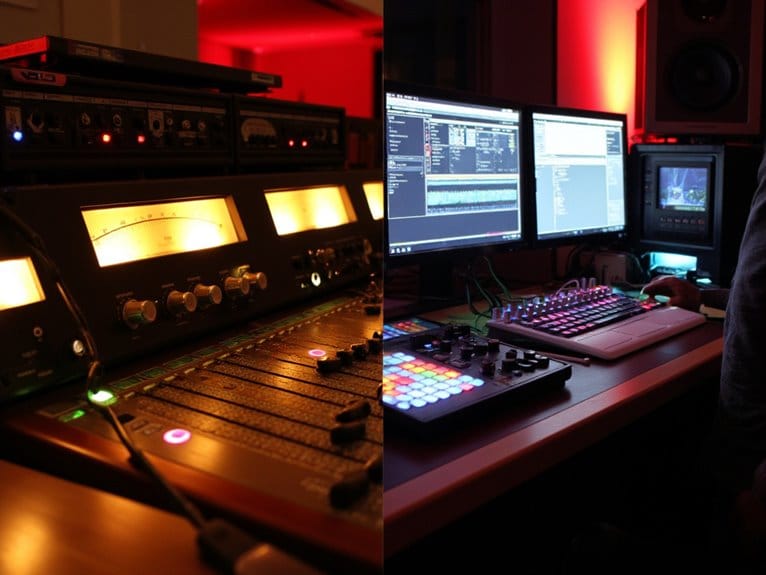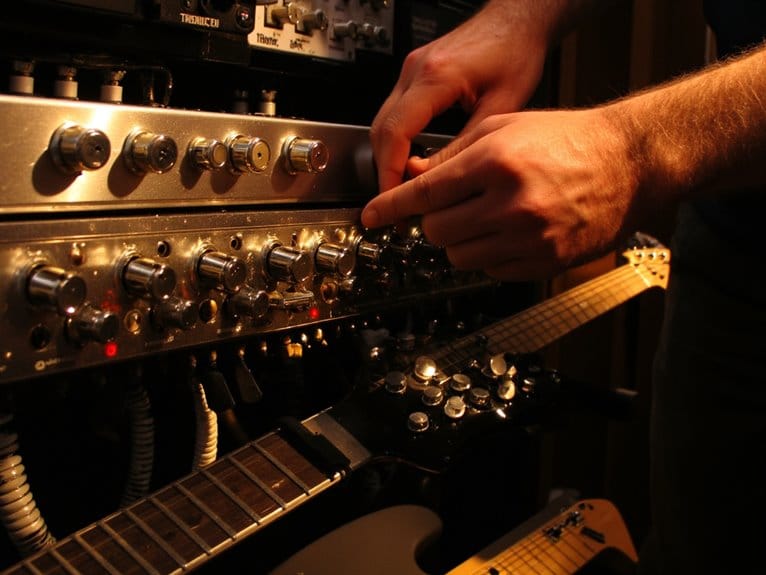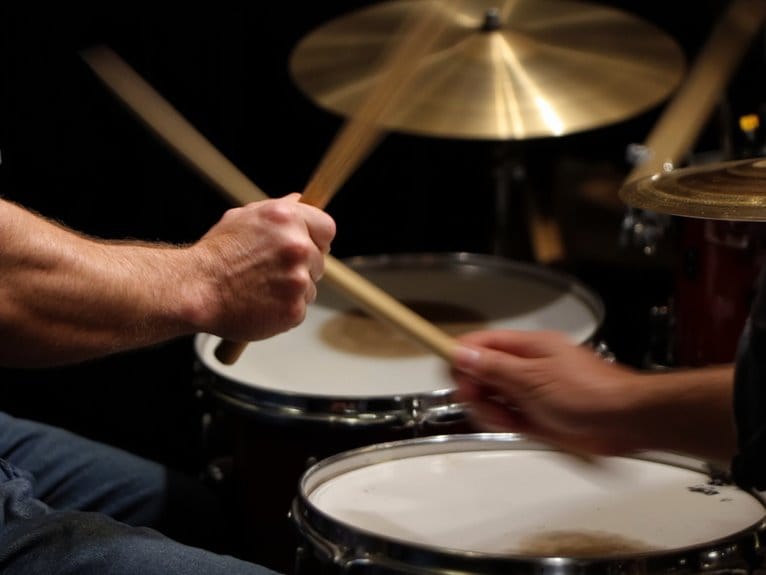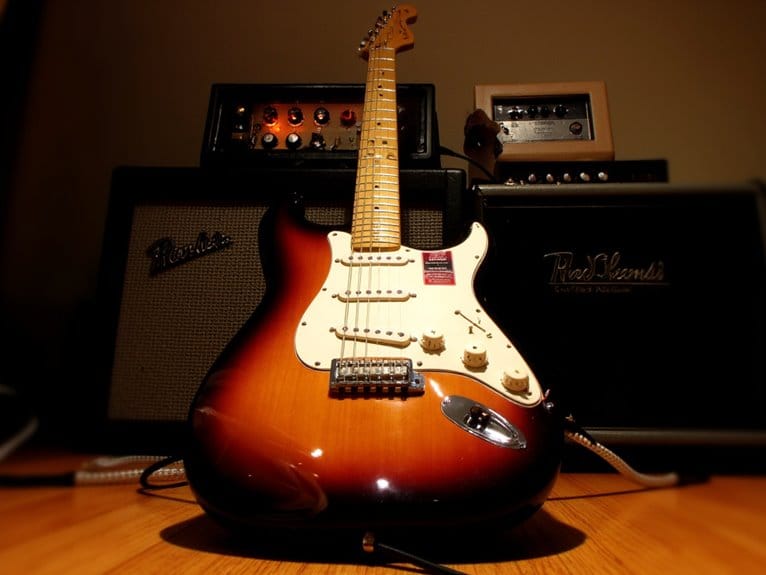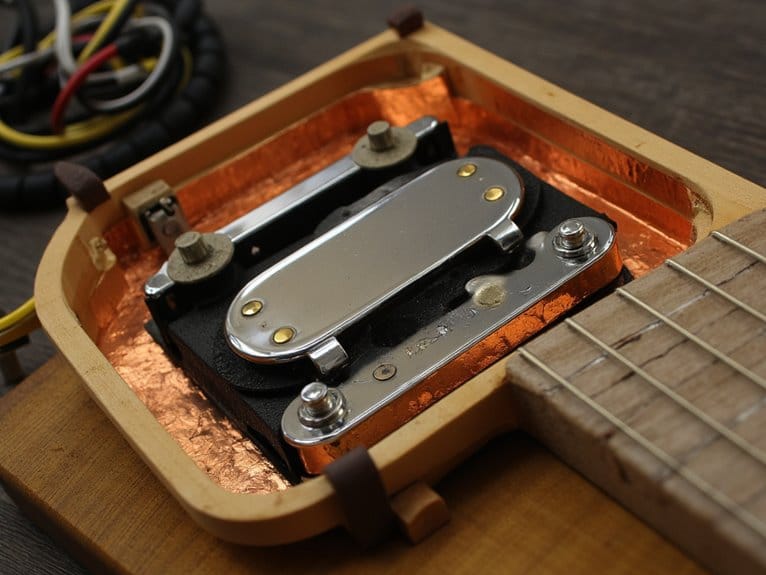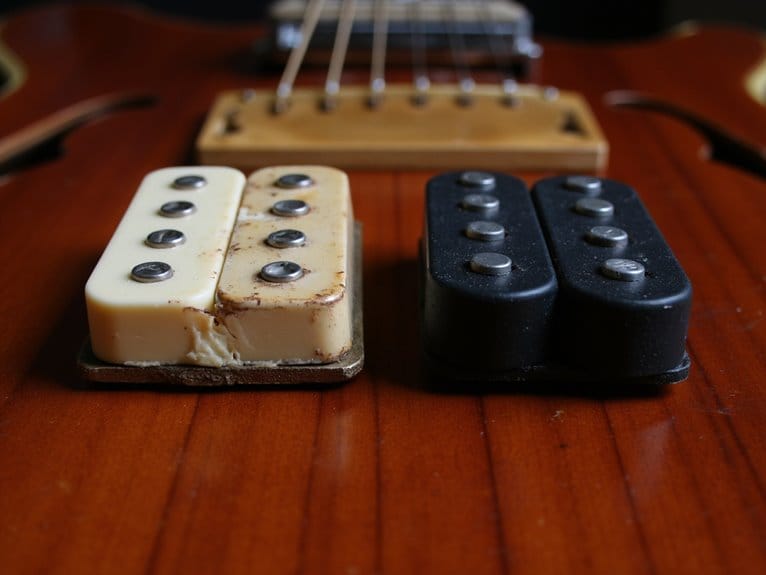Audio Mixing Hardware: Analog Vs Digital Workflows
You’ll find analog mixers deliver harmonic warmth through transformer saturation and offer immediate tactile control with zero latency, making them ideal for live performances and vintage-style recordings. Digital systems provide superior signal clarity, built-in effects, session recall capabilities, and seamless DAW integration, though they require menu navigation and introduce processing delays. While analog gear demands higher maintenance costs and specialist repairs, digital mixers offer expandability through software updates and networked connectivity, with your choice ultimately depending on workflow priorities and the specific sonic character you’re pursuing.
We are supported by our audience. When you purchase through links on our site, we may earn an affiliate commission, at no extra cost for you. Learn more.
Notable Insights
- Analog delivers harmonic warmth through transformer saturation while digital offers superior clarity and precise DSP capabilities.
- Digital systems excel in workflow efficiency with session recall and automation versus analog’s immediate tactile control.
- Analog features intuitive knob-per-function design while digital requires learning complex menu systems and routing matrices.
- Digital mixers provide expandable I/O, software updates, and DAW integration versus analog’s straightforward physical connectivity.
- Analog requires regular maintenance and calibration while digital faces potential obsolescence but offers automated backups.
Understanding Signal Processing Methods
When you’re diving into audio mixing hardware, understanding how signals move through your equipment becomes the foundation for everything else you’ll learn, and I’ve found that grasping these core concepts early saves countless hours of frustration later.
Your analog signal travels as continuous electrical waveforms, closely mirroring original sound waves, while digital signals use discrete binary data through sampling and quantization processes.
Conversion methods between these formats rely on ADCs and DACs, which directly impact audio fidelity through their bandwidth and signal-to-noise ratios.
Digital workflows offer DSP advantages like error correction and precise, repeatable editing, though they introduce processing latency that analog systems avoid.
However, you’ll encounter quantization noise in digital systems, whereas analog processing accumulates degradation throughout the signal path.
Sound Quality Characteristics and Tonal Differences
While working with different mixing hardware over the years, I’ve noticed that the most heated debates among audio engineers often center around sound quality differences between analog and digital systems, and honestly, both camps have valid points worth exploring.
Analog gear delivers harmonic richness through transformer saturation and circuit nonlinearities, creating perceived warmth that many engineers chase. This tonal evolution includes saturation effects that provide musical compression, smoothing harsh transients naturally. Digital systems offer superior signal clarity with neutral frequency shaping, though they lack analog warmth’s character.
| Characteristic | Analog | Digital |
|---|---|---|
| Harmonic Content | Rich, musical distortion | Clean, neutral reproduction |
| Noise Design | Inherent character noise | Superior noise floor reduction |
| Dynamic Nuances | Gradual, pleasing saturation | High headroom, abrupt clipping |
| Frequency Response | Subtle roll-offs, warmth | Flat, consistent bandwidth |
| Consistency | Variable, requires maintenance | Precise, repeatable results |
Professional audio interfaces support 24-bit/192kHz resolution for high-quality recordings, providing exceptional digital conversion that rivals traditional analog processing chains. Modern interfaces achieve impressive specifications with dynamic ranges exceeding 120 dB, delivering professional-grade conversion quality that competes directly with high-end analog gear. Your audio judgments ultimately depend on whether you prioritize digital neutrality or analog’s distortion characteristics.
Workflow Efficiency and User Interface Design
After spending countless hours behind different mixing setups, I’ve learned that workflow efficiency often determines whether a session flows smoothly or becomes a frustrating battle against your own gear.
Digital systems excel at workflow adaptability, letting you save entire sessions, recall complex routing configurations, and swap plugins instantly without rewiring anything.
Analog setups demand meticulous documentation of every knob position, making session recall time-consuming and prone to human error.
However, user interface innovations like digital control surfaces bridge this gap effectively, providing tactile faders and knobs that integrate seamlessly with your DAW while maintaining digital convenience.
Hybrid workflows represent the sweet spot, combining analog’s intuitive physical controls with digital’s automation capabilities and unlimited track counts. Professional interfaces with zero-latency monitoring eliminate the delay between input and output signals that can disrupt the natural feel of analog mixing workflows.
Modern setups often integrate audio interfaces that handle the critical analog-to-digital conversion between your analog mixing console and digital recording environment, enabling seamless hybrid workflows with professional 24-bit resolution.
Learning Curves and Operational Complexity
When you’re choosing between analog and digital mixing hardware, you’ll quickly discover that analog consoles offer immediate, tactile control through their knob-per-function design, allowing you to grab any parameter instantly without maneuvering through layers of menus.
Digital mixers, while incredibly powerful, present a steeper learning curve because you must master their complex menu systems, understand digital signal processing concepts, and develop skills in preset management that simply don’t exist in the analog world.
The shift from analog’s intuitive workflow to digital’s feature-rich but menu-driven interface requires dedicated training time, though I’ve found that the initial complexity often pays dividends in long-term operational efficiency once you’ve conquered the learning curve.
Analog’s Immediate Control Access
The visceral satisfaction of twisting a knob and hearing an immediate response represents analog mixing’s greatest strength, offering what I’ve found to be an unmatched directness that digital systems still struggle to replicate.
Your hands on experience becomes instinctive when each channel provides dedicated controls for level, EQ, panning, and auxiliary sends, eliminating the menu diving that plagues digital workflows.
The tactile feedback from physical faders and rotary knobs creates muscle memory that I’ve watched engineers develop over countless sessions, enabling them to make adjustments without looking.
This knob-per-function layout reduces latency associated with digital command processing, though you’ll sacrifice the convenience of automated recall functions that modern studios increasingly depend on for complex projects. Many budget-conscious engineers turn to affordable audio interfaces that offer zero-latency monitoring to bridge this gap between analog immediacy and digital convenience.
While analog consoles excel in immediate response, digital audio interfaces have evolved to minimize this gap with buffer sizes as low as 64-256 samples, though they still require careful optimization to achieve truly responsive real-time monitoring.
While analog’s knob-per-function simplicity feels intuitive from day one, digital mixers present a learning curve that I’ve seen trip up even experienced engineers who’ve spent decades behind analog consoles.
You’ll find yourself wrestling with menu diving obstacles that slow down real time adjustments, particularly when you’re trying to access EQ settings or routing parameters buried three layers deep.
The digital workflow challenges become apparent when operational error potential increases during live performances, where menu navigation efficiency directly impacts your ability to respond quickly.
Key digital learning impediments include:
- Menu diving requirements – Essential controls hide behind multiple screen layers, reducing tactile feedback limitations
- Complex routing visualization – Digital signal flow concepts aren’t immediately visible on control surfaces
- File management dependencies – Session saving and preset recall add operational steps
- Control surface integration complexity that extends user experience adaptability periods, creating user interface frustrations
The complexity increases further when proprietary driver ecosystems from different manufacturers require specialized knowledge and training, adding another layer to the digital learning process that analog engineers never had to navigate.
Skill Development Requirements
Beyond these interface frustrations lies a broader question about the time investment you’ll need to become truly proficient with each mixer type. I’ve watched countless engineers underestimate how considerably the learning curves differ between analog and digital systems.
Your skill advancement with analog mixers follows a predictable trajectory, mastering physical controls and signal flow within weeks. However, digital systems demand months of understanding DSP concepts, software integration, and complex routing matrices.
I’ve found that knowledge retention varies dramatically between formats. Analog workflows build foundational skills through hands-on repetition, while digital mastery requires continuous learning of software updates and evolving features that can overwhelm newcomers seeking straightforward audio mixing solutions. Digital mixers require menu navigation for flexibility in routing, which adds complexity to the learning process compared to analog’s intuitive dedicated channel strips.
The transition from analog to digital is still ongoing, with future trends indicating more advanced digital technologies becoming standard in live sound.
Connectivity Options and Input/Output Capabilities
When selecting audio mixing hardware, I’ve found that connectivity options and input/output capabilities often determine whether you’ll love or regret your purchase, since these features directly impact how easily you can integrate the mixer into your existing setup.
Connectivity and I/O capabilities make or break your mixer experience—they determine seamless integration versus frustrating workflow bottlenecks.
Modern connectivity trends favor digital mixers with their superior output formatting flexibility, while analog boards maintain appeal through their straightforward approach.
Here’s what separates analog from digital connectivity:
- Physical controls – Analog mixers provide dedicated knobs per channel, while digital units offer touchscreen interfaces with layered access.
- I/O expansion – Digital mixers connect to remote stage boxes via Dante or AES50, analog requires physical cable runs.
- Recording integration – Digital boards feature built-in USB/SD recording, analog needs external interfaces.
- Effect processing – Digital includes internal effects, analog demands outboard gear.
Your workflow complexity determines which approach suits you best. When choosing input connectivity, consider whether you need USB/XLR compatibility for microphones, as this dual connectivity offers flexibility for both professional and home studio applications. Consider planning for future growth by selecting mixers with scalable I/O options to avoid outgrowing your equipment as your setup expands.
Expandability and System Integration
As your audio needs evolve and grow more complex, I’ve learned that expandability and system integration capabilities often become the deciding factors that separate a mixer you’ll outgrow in six months from one that’ll serve you for years.
Analog limitations become apparent when you’re constantly buying rack units, dealing with cable spaghetti, and facing physical space constraints that demand increasingly larger consoles.
Meanwhile, digital adaptability shines through software updates, networked stageboxes, and built-in processing that scales without additional hardware costs.
I’ve found digital mixers integrate seamlessly with DAWs through multi-track USB interfaces, while analog setups typically offer only stereo outputs to computers.
When integrating with digital audio workstations, selecting the mixer as your primary I/O device ensures optimal performance and proper signal routing.
Though hybrid approaches combine tactile analog control with digital flexibility, your budget and technical comfort level ultimately determine which expandability path makes sense for your workflow.
Physical Footprint and Portability Considerations
When you’re evaluating mixing hardware for your setup, the physical dimensions and weight differences between analog and digital units will noticeably impact your workspace requirements, transport logistics, and overall workflow efficiency.
You’ll find that digital mixers consistently pack more channels into smaller footprints through integrated circuitry, while analog boards demand substantially more desk space, additional outboard gear, and heavier-duty transport cases that can strain your back and budget.
Your choice between these technologies hinges on balancing the immediate tactile control of larger analog consoles against the space-saving, travel-friendly advantages of compact digital units that streamline both setup time and breakdown procedures.
Size and Weight Differences
The physical footprint debate between analog and digital mixing hardware isn’t just about desk space—it’s fundamentally about how much gear you’re willing to haul around and how efficiently you can integrate your setup into existing workflows.
Analog consoles consistently demonstrate larger size implications due to their dense circuitry, robust metal chassis, and individual component requirements, while digital mixers offer clear weight advantages through integrated processing and lighter construction materials like aluminum alloys.
Here’s what you’ll encounter when comparing these systems:
- Transport burden – Analog mixers require considerably more effort for mobile setups.
- Desk real estate – Digital units maximize channel count within compact footprints.
- Remote capability – Tablet control reduces on-site hardware requirements.
- Studio integration – Digital’s modularity supports modern minimalist workflows.
Choose based on your mobility needs versus traditional workflow preferences. Lightweight designs made from durable materials ensure longevity while maintaining portability for content creators who need reliable performance across different venues. Digital mixing hardware also eliminates the need for extensive audio interface drivers that analog systems often require when connecting to computer-based recording setups.
Channel Density Efficiency
Beyond the obvious weight concerns, channel density represents where digital mixing technology truly flexes its engineering muscles, packing dramatically more inputs into spaces that would barely accommodate half as many analog channels.
You’ll find digital consoles like the Midas M32R supporting 40 inputs within footprints comparable to 16-channel analog desks, achieving this through clever digital integration that eliminates bulky analog circuitry.
Channel expansion becomes remarkably straightforward with networked stage boxes, allowing you to position inputs closer to sources while keeping your mixing position compact and uncluttered.
Meanwhile, analog mixers demand extensive multicore snake cables and considerably larger surface areas to achieve similar channel counts, creating transport nightmares that’ll test your roadie’s patience and your venue’s available space constraints.
Transport and Setup
While channel density showcases digital’s engineering prowess, it’s the real-world logistics of hauling gear from venue to venue that’ll make you appreciate compact design philosophy in ways your back muscles will thank you for later.
Digital convenience shines through reduced physical footprints, while analog simplicity demands more space but offers immediate tactile access.
Transport logistics reveal stark contrasts in user preferences:
- Weight distribution – Digital mixers typically weigh 30-50% less than analog counterparts
- Road case efficiency – Compact digital units fit smaller cases, reducing transport costs
- Setup strategies – Digital recall functions eliminate repetitive configuration challenges
- System requirements – Analog needs external processors, increasing workflow impacts
Configuration challenges with digital menus can slow initial setup, though saved presets accelerate subsequent sessions, fundamentally reshaping transport logistics for touring professionals. Most effective compact digital mixers weigh under two pounds while delivering professional-grade components, making them ideal for mobile audio applications where portability remains paramount. Professional studios benefit from metal chassis construction which provides superior durability during frequent transport while maintaining structural integrity under demanding conditions.
Durability and Environmental Resistance
When you’re investing in audio mixing hardware, durability isn’t just a nice-to-have feature—it’s what separates equipment that’ll serve you reliably for years from gear that’ll leave you scrambling for replacements mid-project.
Analog mixers face significant challenges with hardware longevity, as their exposed faders, knobs, and switches deteriorate through constant mechanical contact, while environmental impact from dust, humidity, and temperature fluctuations can cause thermal drift and circuit corrosion.
Analog mixers suffer from exposed controls that wear down through use and environmental factors that degrade internal circuits over time.
Digital mixers offer superior resistance to these hazards through sealed controls, surface-mount electronics, and fewer moving parts, though their touchscreens remain vulnerable to impacts and spills.
While analog gear requires more maintenance and careful handling, digital units provide better protection against electromagnetic interference and power inconsistencies.
Maintenance Requirements and Longevity
Understanding how environmental factors affect your mixing hardware leads directly to the practical reality of keeping that equipment running smoothly over years of use.
Your maintenance approach will fundamentally differ between analog and digital systems, with each presenting distinct advantages and challenges that affect long-term ownership costs.
Here’s what you’ll encounter with each system:
- Analog restoration demands regular calibration, tube replacements, and careful cleaning protocols to maintain pristine audio quality.
- Digital upgrades offer automated backups and software improvements, reducing hands-on maintenance while extending functionality.
- Analog mixers require specialist knowledge for repairs but remain serviceable for decades with proper component replacement.
- Digital systems face obsolescence challenges as newer standards emerge, potentially requiring complete hardware replacement despite minimal physical wear.
Beyond regular maintenance schedules, both analog and digital systems require careful attention to impedance matching to prevent signal degradation and ensure optimal performance throughout their operational lifespan.
Initial Investment and Total Cost of Ownership
When you’re evaluating audio mixing hardware, the sticker price represents just the tip of the financial iceberg, and I’ve learned through years of gear acquisition that understanding both upfront purchase costs and long-term ownership expenses can save you from budget surprises down the road.
Your initial investment varies dramatically between analog and digital mixers, with entry-level analog consoles typically offering lower barriers to entry while digital units demand higher upfront costs but potentially deliver greater long-term value through integrated processing capabilities.
The total cost of ownership extends far beyond that first purchase, encompassing everything from additional outboard gear and software licenses to training investments and operational efficiencies that can make or break your budget over time.
Total ownership must account for additional costs like cables and software that often get overlooked during the initial planning phase but can significantly impact your overall investment.
Upfront Purchase Costs
The most significant barrier to entering the analog mixing world isn’t the learning curve or technical complexity—it’s the substantial upfront investment that can easily reach five figures for a professional-grade setup.
When conducting an analog investment comparison against digital alternatives, the numbers tell a stark story that’ll make your wallet weep.
Upfront Cost Breakdown:
- Premium analog channel strips like Neve 1073 preamps paired with 1176 compressors cost thousands, while entire digital plugin bundles offer similar processing power for hundreds.
- Infrastructure requirements including specialized cabling, rack units, and power supplies add substantial overhead to your initial analog budget.
- Digital cost analysis reveals DAW licenses and plugin packages typically run under $1,000 for extensive mixing capabilities.
- Hybrid setups allow strategic analog investment where it matters most while leveraging cost-effective digital tools elsewhere.
Additionally, upgrading to USB-C interfaces provides faster data transfer and reliable power delivery, making them a worthwhile investment for studios transitioning between analog and digital workflows.
Long-term Ownership Expenses
Beyond that initial sticker shock, analog mixing gear transforms from a one-time purchase into a financial relationship that’ll cost you hundreds or thousands annually in ways digital workflows simply don’t. You’re looking at frequent calibration, tube replacements, and capacitor swaps that add up faster than you’d expect, while digital systems sip power and rarely need physical maintenance beyond occasional firmware updates.
The long term trends reveal an interesting paradox: analog gear holds superior resale value, often appreciating like vintage guitars, while digital hardware depreciates rapidly due to technological obsolescence.
Your investment returns depend heavily on usage patterns—studios running analog consoles daily face mounting operational costs, whereas digital workflows frontload expenses but maintain lower total cost of ownership through energy efficiency and reduced maintenance requirements.
Modern USB-C audio interfaces exemplify this cost-efficiency advantage, offering professional 24-bit/192kHz recording capabilities with minimal ongoing expenses compared to their analog counterparts.
Application-Specific Performance Benefits
While I’ve spent countless hours comparing different mixing setups across various scenarios, I’ve learned that choosing between analog and digital hardware isn’t just about personal preference—it’s about matching your specific application needs with each technology’s inherent strengths.
Your workflow adaptability requirements will determine which system delivers peak results:
- Live sound reinforcement benefits from digital mixers’ preset recallability, complex routing capabilities, and compact footprint for tour-friendly setups.
- Vintage-style recordings favor analog’s harmonic saturation and musical coloration, enhancing audio fidelity through natural compression characteristics.
- Modern pop production leverages digital’s processing capabilities, built-in effects, and seamless DAW integration for precise automation.
- Budget-conscious studios appreciate digital’s cost-effective bundled features, while high-end facilities prioritize analog’s design aesthetics and user preferences for tactile control, despite increased setup complexity.
Live Sound Environment Suitability
When you’re selecting mixing equipment for live sound applications, the venue’s physical dimensions and acoustic characteristics will fundamentally determine whether analog or digital systems better serve your operational needs.
Your real-time performance requirements, including the speed of parameter adjustments and the complexity of signal routing during active shows, create distinct demands that each mixer type handles through different operational philosophies.
Understanding how venue size constraints interact with your need for immediate tactile control versus extensive processing capabilities becomes essential for making informed equipment decisions that’ll actually work when you’re under pressure.
Venue Size Considerations
How dramatically does venue size transform your audio mixing requirements, and what specific considerations should guide your equipment decisions?
I’ve discovered that venue acoustics fundamentally reshape your entire approach, requiring careful evaluation of speaker placement strategies that accommodate everything from intimate 50-person clubs to massive 10,000-capacity arenas where sound dispersion becomes critically complex.
Your equipment compatibility needs shift dramatically as performance adaptability demands increase with venue scale, and audience interaction patterns change based on spatial dynamics:
- Small venues (under 200 people) benefit from point-source speakers and simplified mixing boards.
- Medium venues (200-1,000) require strategic subwoofer placement and expanded input channels.
- Large venues (1,000-5,000) demand line arrays and sophisticated digital processing capability.
- Massive venues (5,000+) necessitate delay towers and thorough acoustic modeling software.
Real-Time Performance Demands
Split-second decisions define the heartbeat of live sound mixing, where millisecond delays can derail your entire performance and audience connection hinges on your ability to adapt instantly to unexpected changes.
Analog mixers excel in real time integration through zero-latency signal flow, enabling immediate response when performers suddenly change dynamics or when feedback threatens to destroy your mix.
Digital consoles, despite their processing delays, compensate through efficient DSP optimization and automated scene recalls that enhance performance adaptability.
While you’ll navigate menu systems more slowly on digital boards, their preset capabilities let you prepare for anticipated changes beforehand.
The trade-off becomes clear: analog delivers instantaneous tactile control, while digital provides sophisticated preparation tools for complex live scenarios.
Studio and Recording Session Advantages
Although I’ve spent countless hours debating the merits of different mixing approaches with fellow engineers, I can tell you that the choice between analog and digital hardware in studio environments isn’t just about sound quality—it’s fundamentally about how you want to work, the physical space you’re operating in, and the specific demands of your recording sessions.
Your studio’s workflow efficiency depends heavily on matching hardware to session dynamics and studio acoustics:
- Physical Space Requirements: Analog gear demands dedicated rack space and proper ventilation, while digital setups maximize your studio’s real estate efficiency.
- Session Recall Speed: Digital systems instantly restore complex mixes, whereas analog requires manual documentation and careful setting recreation.
- Client Collaboration: Digital workflows enable real-time remote sharing and non-destructive editing during sessions.
- Maintenance Demands: Analog hardware needs regular calibration and servicing, though it offers immediate tactile control.
Making the Right Choice for Your Needs
When you’re standing at the crossroads between analog warmth and digital precision, the decision ultimately comes down to understanding your specific mixing priorities, budget constraints, and the type of audio work that’ll define your career trajectory.
If you’re tracking bands where immediacy matters, analog mixers provide that tactile control you’ll crave during those marathon recording sessions.
However, if you’re handling complex productions with extensive automation requirements, digital systems offer the recall and flexibility that’ll save your sanity.
Digital systems deliver the recall and automation flexibility that complex productions demand, preserving your creative flow when projects get intricate.
Your budget plays a significant role too—analog gear requires upfront hardware investments, while digital systems grow through software updates.
Consider your physical space limitations, since analog setups can quickly overwhelm smaller studios.
Ultimately, hybrid workflows often provide the best compromise, letting you capture analog warmth while maintaining digital precision.
Frequently Asked Questions
Can I Use Both Analog and Digital Mixers Together in One Setup?
You can definitely combine both analog and digital mixers in what’s called a hybrid setup, though you’ll need to carefully plan your analog signal flow to avoid complications.
I’ve found that digital integration challenges typically involve routing outputs from your audio interface to the analog console’s line inputs, then sending the mixed signal back to your DAW for recording, which requires proper cabling and level matching.
Do Digital Mixers Work During Power Outages or Electrical Failures?
Digital mixers won’t work during power outages since they’re fundamentally computers that shut down immediately when electricity cuts out.
Unlike analog mixers that can sometimes keep functioning briefly, you’ll lose complete control and need several minutes for rebooting once power returns, which honestly can ruin live performances.
I’d strongly recommend investing in power backup solutions like UPS systems to guarantee proper mixer reliability during electrical failures.
Which Mixer Type Holds Its Resale Value Better Over Time?
Analog mixers generally hold their resale value better than digital models, though I’ve seen exceptions with high-end digital consoles.
You’ll find that vintage analog gear often appreciates due to market demand from studios seeking that classic warmth, while digital mixers depreciate faster as newer technology emerges.
Brand reputation matters considerably for both types, but analog’s simplicity and durability create more consistent long-term value retention.
Are There Hybrid Mixers That Combine Analog and Digital Features?
Yes, hybrid mixers absolutely exist and they’re becoming increasingly popular among audio professionals who want the best of both worlds.
These units combine analog preamps, EQs, and tactile controls with digital effects, USB connectivity, and DAW integration.
Popular models like the Yamaha MG10XU and Mackie ProFX series offer hybrid mixer advantages including analog warmth with modern mixing capabilities like digital recall, automation, and seamless computer integration for today’s workflows.
Do Professional Musicians Prefer Analog or Digital Mixers More Often?
You’ll find that professional musicians split their preferences based on specific needs, with touring artists and audio engineers gravitating toward digital mixers for their workflow efficiency and advanced routing capabilities.
However, many professionals still maintain a strong analog sound preference, particularly for recording and intimate venues where that warm, natural character matters most.
Your choice ultimately depends on whether you prioritize convenience or sonic character.
On a final note
You’ll find that choosing between analog and digital mixing hardware isn’t really about one being superior to the other, but rather about matching the right tool to your specific workflow, budget constraints, and sonic preferences. Whether you’re drawn to analog’s warm saturation and tactile control surfaces, or digital’s recall capabilities and extensive processing power, both approaches offer legitimate paths to professional results when you understand their respective strengths.

